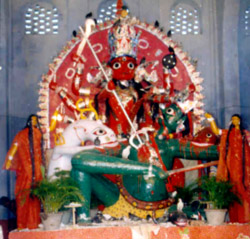Koch Bihar district of West Bengal state houses a city having the name Khagrabari. For administrating the city a municipality has been set up .
There are numerous demographers that have depicted the demographical scenario of the town of Khagrabari. Regarding this, the Census report of India that has been issued in the year 2001 merits to be mentioning. Significant data about Khagrabari viz. population status, literacy etc can be traced out from it . As per the report, the total population of Khagrabari has been enumerated to be 19,762. Out of the total population of Khagrabari, females comprises of 49 percent, while the male populace is 51 percent. In Khagrabari town, 11 percent of the total population is below six years of age.
As far as the average literacy rate of Khagrabari is concerned, it has been found out that it has a percentage of 76. It naturally draws one to derive to a conclusion that it is higher than the average literacy rate of India. 59.5 percent is the measurement of average literacy rate of India. To be specific, rate of male literacy of Khagrabari is 82 percent, while female literacy rate is less than that of males. In other words the female literacy rate of Khagrabari is 71 percent.
Just like many places of India , in Koch Bihar district also people ardently carry on the all the activities of agriculture. Chief crops that are grown here are tobacco, jute, paddy, rice and many more.
 Places of interests of this district like Baradebi Bari Temple, Madan Mohan Temple, Baneswar Siva Temple, Ardhanariswar Temple, Brahmo Mandir and Dangar Ayee Temple create an appeal to all the devotees. From Khagrabari also people can go to these places. Since this Khagrabari is a part of this district it is quite evident that people here also pursue the practice.
Places of interests of this district like Baradebi Bari Temple, Madan Mohan Temple, Baneswar Siva Temple, Ardhanariswar Temple, Brahmo Mandir and Dangar Ayee Temple create an appeal to all the devotees. From Khagrabari also people can go to these places. Since this Khagrabari is a part of this district it is quite evident that people here also pursue the practice.
For facilitating easy accessibility, Coochbehar Airport and New Coochbehar Railway Station are playing an indispensable role.
More on West Bengal
| Tribes of West Bengal | Bengali Theatre | Temples of West Bengal | Colleges of West Bengal |
| Tribal jewellery of West Bengal | Bengali Language | Districts of West Bengal | Medical colleges of West Bengal |
| Airports in West Bengal | Crafts of West Bengal | Cities of West Bengal | West Bengal Cricketers |
| Monuments of West Bengal | Bengali Wedding | Personalities of West Bengal | Bengali Literature |
| Folk Dances of West Bengal | Bengali Folktale | Museums of West Bengal | Bengali Newspapers |
| Festivals of West Bengal | Bengali Cinema | Universities of West Bengal | Places to See in West Bengal |



















